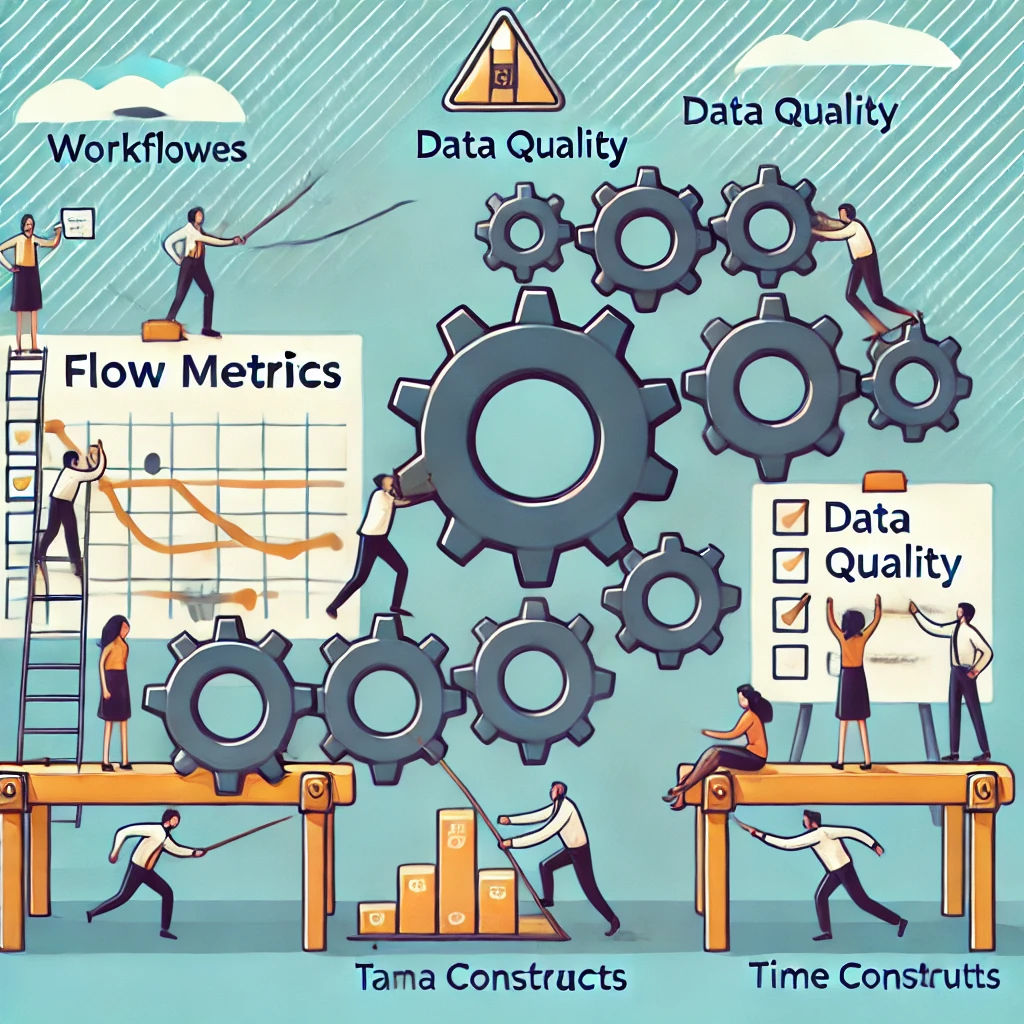
“We are not ready”: Demystifying the prerequisites and overcoming obstacles to the implementation of Flow Metrics
In many organizations seeking to improve their operational performance using Lean-Agile methodologies, the implementation of Flow Metrics is often perceived as a complex step.
Among the most common obstacles, we often hear the famous: “We are not ready”.
This observation, although it may be well-founded, is also symptomatic of a certain reluctance to change, particularly in organizations that have been engaged in Agile@Scale for many years.
We will explore the real prerequisites for implementing Flow Metrics and the obstacles that teams must overcome to move from reflection to action.
We will also examine why waiting to “be ready” can be a barrier to continuous improvement.
Why are Flow Metrics essential for continuous improvement?
Flow Metrics provide valuable insight into how activity flows through a system, measuring key metrics such as Flow Time, Throughput, Flow Efficiency, and more. Their goal is to provide visibility into performance, help identify bottlenecks and accelerate continuous improvement loops.
Yet, in many organizations, implementing these metrics is seen as an effort that requires significant preparation, dedicated resources, and adjustment of tooling and processes.
Prerequisites for implementing Flow Metrics: Simpler than it seems
Although some adjustments are necessary to get the most out of Flow Metrics, the prerequisites are often less complex than you might imagine. Here are the key elements to put in place to get started.
1 – Establish a data-driven culture
The first step to successfully implementing Flow Metrics is to create a corporate culture where decisions are guided by data (the famous DATA).
This means teams need to understand the importance of data, how it influences processes, and why metrics are essential for continuous improvement.
A data-driven culture also implies that each member of the team, whatever their role, feels involved in using metrics to drive their work.
Why it is important
Without a strong data orientation, Flow Metrics risk being perceived as simple numbers or control tools. A data-driven culture ensures that teams see these metrics as levers for continuous improvement and not as constraints.
Implementation advice
Start by raising awareness of the importance of data throughout the organization through workshops and training.
Explain how Flow Metrics, such as Flow Time, Throughput or Flow Efficiency, help optimize work processes.
Encourage regular discussions around data during agile rituals (retrospectives, daily meetings), so that teams can analyze their performance and actively engage in continuous improvement.
2 – Have adapted tools and standardized processes
The tools used by the team, such as Jira, and the processes around them should be standardized and aligned with the organization’s goals. Adapted tools collect the data necessary for Flow Metrics, while standardized processes ensure that all teams use the same methods to manage tasks and workflows.
Why it is important
Poorly configured tools or inconsistent processes make it difficult to measure and analyze data.
If each team follows different practices, it becomes impossible to compare performance, identify trends and optimize overall flow.
Flow Metrics, to be effective, must rely on tools that faithfully reflect business processes.
Implementation advice
Standardize workflows in your task management tool. For example, in Jira, make sure that the process steps are well defined and uniform between teams working on the same area.
Use tools like Wiveez to automate data collection and visualize Flow Metrics consistently.
Also make sure your teams are trained to use these tools and understand the importance of updating task statuses in real time.
3 – Take care of data quality
Data quality is an essential factor in obtaining reliable Flow Metrics. If the data collected is incomplete, incorrect, or outdated, the metric results will be distorted.
Taking care of data quality means ensuring that every work item is well-tracked, updated in real time, and properly categorized. It is the role of each member of a team and an organization to ensure this and guarantee it, even more so the RTE, Scrum Master and Agile Coach.
Why it is important
Poor data quality leads to faulty analyses, which can lead to poor decisions. For example, a Flow Time that seems too long could actually be due to a ticket that was not closed correctly, or to tasks not updating in the tool.
By ensuring data quality, you maximize the reliability of metrics and their usefulness to teams.
Implementation advice
Implement regular data audits in your task management tools.
Ensure teams are trained on the importance of continuously updating tasks in Jira, and encourage regular review practices for pending items.
Automatic checks can also be configured to alert when certain tasks remain in one status too long or are incorrectly populated.
4 – Have leadership at all levels
Leadership is an essential ingredient to drive change and ensure the successful adoption of Flow Metrics. This is not just formal leadership (by managers or leaders), but also informal leadership within teams, where everyone plays a role in integrating these practices and promoting improvement. continues.
Why it is important
Without strong support from leaders, Flow Metrics risk remaining underutilized.
It is essential that leadership leads by example by actively using these metrics to guide decisions and adjust processes. Additionally, good leadership will encourage teams to adopt a data-driven approach, openly share their results, and collaborate to improve workflows.
Implementation advice
Involve leaders at all levels in the use of Flow Metrics. Scrum Masters, Product Owners, RTEs, and Managers must integrate these metrics into their strategic discussions and decisions.
For example, a manager can use Throughput to assess teams’ delivery capacity, while a Scrum Master can focus on Flow Efficiency to identify obstacles to productivity.
Also encourage informal leaders to become ambassadors of this culture and support their colleagues in adopting these practices.
The most common obstacles: Demystifying the famous “We’re not ready”
It is common to hear teams say “We are not ready to implement Flow Metrics”. Here is an analysis of what this phrase often hides and how to overcome these obstacles.
1 – “Our workflows are not yet perfect”
The obstacle
Many people are hesitant to implement metrics until their processes are fully defined, for fear that the data will be false or misleading.
The reality
No workflow is perfect at the start, and that is precisely the goal of Flow Metrics: to identify problems and optimize the process over time. Waiting until everything is perfect before you start measuring prevents proactive improvement.
Solution
Take an iterative approach. Start with an existing process, even if it is imperfect, and use Flow Metrics to gradually refine it. Continuous improvement is the heart of agility.
2 – “We don’t have enough data”
The obstacle
Some teams feel they don’t have enough historical work or data for Flow Metrics to be useful.
The reality
Flow Metrics are useful at all maturity levels of teams. Whether you have limited data history or partially defined workflows, the first measurements will already give you valuable insight. Over time, the data will become richer and more robust.
Solution
Start with whatever data is available, even if limited. Metrics like Flow Time and Aging will already give you actionable information, which you can refine with more data as the weeks go by.
3 – “We don’t have time”
The obstacle
Adopting Flow Metrics takes time to set up tools, train teams and adjust processes, and many teams find they are too busy to tackle it.
The reality
This is a false economy. Teams that don’t take the time to implement effective analytics tools like Flow Metrics continue to experience undetected inefficiencies, blockages, and delays. The initial effort to implement metrics is largely offset by long-term productivity gains.
Solution
Make it a strategic priority. Although it takes time at the start, Flow Metrics will reduce delays and improve efficiency, which will result in significant time savings in the long term.
4 – “We are concerned that metrics are used to judge performance”
The obstacle
Some teams fear that Flow Metrics are used as a monitoring tool, rather than as a lever for continuous improvement.
The reality
This fear is legitimate if the metrics are poorly understood. However, Flow Metrics should be seen as a tool to diagnose processes and not to judge the individual performance of developers or teams. They are used to identify bottlenecks, not to sanction delays.
Solution
Emphasize that Flow Metrics are indicators of processes, not people. Use them in a spirit of transparency and continuous improvement, involving the team in improvement decisions.
Prohibit any use of Flow Metrics for individualized performance measurements. Wiveez was created with this philosophy.
Our advice – Act now rather than waiting until you are “ready”
Waiting until everything is perfect before implementing Flow Metrics is an approach that can slow down continuous improvement.
In an agile environment, it is essential to start small, measure, learn and constantly improve. Obstacles, such as imperfect workflows or lack of time, should not be a reason to delay the adoption of flow metrics.
On the contrary, these tools will allow you to gain visibility into your current processes and accelerate improvement.
Do not hesitate to set up change management, in order to support teams in their learning and in the implementation of Flow Metrics, as well as in the culture necessary for their proper use.
Ultimately, no one is ever “completely ready,” but it is precisely by adopting Flow Metrics that you will be able to transform this reluctance into an opportunity for lasting improvement.



